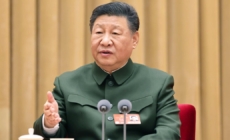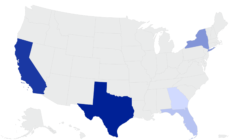-
Map Shows Which Countries Will Have to Pay Visa Integrity Fee to Enter US - 14 mins ago
-
Ellen DeGeneres ‘would love’ to host again but says talk shows may not work today - 17 mins ago
-
Discover the Spellbinding Beauty of the Körös Region in the South - 21 mins ago
-
Deaf, mute, terrified: ICE arrests DACA recipient, sends him to Texas - 26 mins ago
-
Last Night in Baseball: This Dodgers Win Had Everything - 29 mins ago
-
China imposes exit bans on U.S. Department of Commerce employee and a Wells Fargo banker - 31 mins ago
-
How to hand off data privacy responsibilities for older adults to a trusted loved one - 46 mins ago
-
Map Shows States Seeing Surging Freight Demand Amid Logistics Crisis - 53 mins ago
-
Cycling and Equestrian Sports Receive Huge Boost in the Szeged Region - 54 mins ago
-
3 U.S. Marine brothers toughest mission: Getting dad free from ICE - about 1 hour ago
US Military Plans Reaper Drone Operations Near China, North Korea
The United States will reportedly deploy the MQ-9 armed reconnaissance drone, commonly known as the Reaper, to South Korea amid growing threats from China and North Korea.
The U.S. Seventh Air Force—which commands air operations in South Korea—told Newsweek that it could not discuss potential or planned operations as a matter of policy.
Newsweek has contacted the Chinese Defense Ministry for comment via email. The North Korean Embassy in China did not immediately respond to a written request for comment.
Why It Matters
Following the Korean War and the signing of a mutual defense treaty, the U.S. military has approximately 28,500 personnel—along with associated armaments such as fighter aircraft—in South Korea to deter provocations and attacks by nuclear-armed North Korea.
While facing North Korea’s growing military threat—including through the development of a drone that closely resembles America’s Reaper aircraft—South Korea has also been challenged by China’s maritime activities in the disputed waters between the two countries.
What To Know
Citing military officials, South Korean newspaper The Chosun Daily reported on Monday that, beginning in September, the MQ-9 drone is scheduled for a three-month extended rotational deployment in South Korea, during which it will be stationed at Kunsan Air Base.
The Reaper drone, which is designed to conduct a range of missions—from intelligence, surveillance, and reconnaissance to precision strikes—has been featured in exercises held in South Korea, including its first live-fire drill on the Korean Peninsula in April 2024.
Staff Sgt. Daniel Brosam/U.S. Air Force
“Our personnel are equipped and prepared to carry out their missions with precision and professionalism,” the U.S. Seventh Air Force told Newsweek, adding that the unit remains in a state of readiness while sustaining and strengthening the alliance with South Korea.
The planned deployment, if confirmed, would mark the U.S. drone’s longest stint in the allied country to date, according to the report. This move comes as the U.S. Air Force is set to complete the withdrawal of its South Korea-based A-10 attack aircraft by September 30.
The replacement of the A-10 attack aircraft—which is designed to counter armored vehicles such as tanks—with a surveillance-focused aerial platform reflects the Pentagon’s intention to deter both North Korea and China, a South Korean military official told The Chosun Daily.
According to the U.S. Air Force, the Reaper aircraft is remotely controlled by a pilot and a sensor operator, with a flight range of 1,150 miles. The drone is capable of carrying up to 3,750 pounds of payload, including eight Hellfire laser-guided air-to-ground missiles.
What People Are Saying
Yang Uk, research fellow at the Asan Institute for Policy Studies in South Korea, told The Chosun Daily: “The MQ-9 has strike capabilities, but it is fundamentally a surveillance platform.”
The U.S. Air Force wrote in a fact sheet of the MQ-9 drone: “The Reaper is employed primarily as an intelligence-collection asset and secondarily against dynamic execution targets. Given its significant loiter time, wide-range sensors, multi-mode communications suite, and precision weapons, it provides a unique capability to perform strike, coordination, and reconnaissance against high-value, fleeting, and time-sensitive targets.”
What Happens Next
It remains to be seen whether the U.S. will deploy additional aircraft to South Korea to bolster its capabilities around the Korean Peninsula. In late June, a number of upgraded F-16 fighter jets were relocated from Misawa Air Base in Japan to Osan Air Base in South Korea.
Source link































